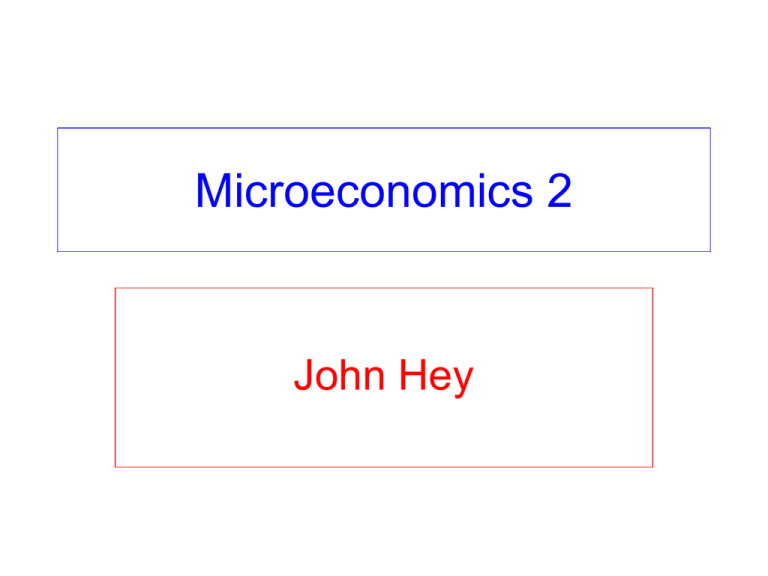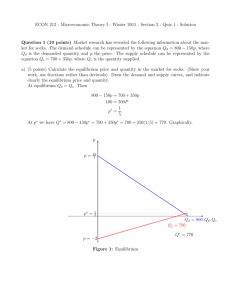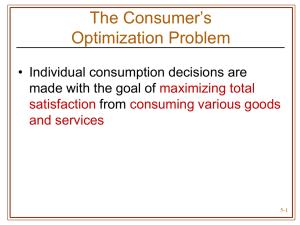Lecture 5: Preferences
advertisement

Microeconomics 2 John Hey New Facebook page • Liz Valeska and Michaela Lucas have very kindly set up a Facebook page: • https://www.facebook.com/groups/406626 752773171/ • I am slowly learning how to use it. • Some students have reported problems in seeing Lecture 2. Odd! It is the browser. Office Hours of TFs • All in Alcuin SCR • Daniel Howdon: Thursdays 14.00 to 15.00 • James Lomas: Mondays 15.00 to 16.00 • Dominic Spengler: Fridays 11.00 to 12.00 • A P.S. About Japanese beer. A little bit of methodology • • • • • • • What is economics all about? Exchange. What should economists do? Predict. Look at policy effects. But first they need to describe/explain. Is this a purely statistical exercise? What is the role of theory? Do we need theory? Yes - to systematise our data analysis. (variables, functional forms) We need models of behaviour. And we need to test them. We start simple and complicate if necessary (by which I mean when the simple models do not explain enough of the data). • At the moment we are doing demand and supply theory. In a sense we are doing everything. What do you need to know? • Driving a car; being a technician; do you have to do one to do the other? • I personally think that understanding is more difficult than maths. • If you find things too simple now, you should ask yourself what simplifications I am making and what are the implications. But concentrate on the method. • Econometrics? The same here – the method. Next two lectures • The Lecture on Wednesday will be Lecture 7 on Chapter 7. • Next Monday we will study Lecture 6 on Chapter 6. • Today’s lecture is essentially definitional: it defines various terms describing preferences. • The implications are in Lectures 6 and 7. Preferences • Preferences are fundamental. • We know that demand and supply depend upon preferences. • We know that the indifference curves of an individual are given by/represent the preferences of that individual. • Up till now we have assumed a particular kind of preferences – quasi-linear – where the indifference curves are vertically parallel. Preferences • Today we study other types of preference. • Economists have made a catalogue of the types that we observe in reality. • We cannot study all these types. • We make an important selection: Perfect Substitutes, Perfect Complements, Cobb-Douglas, Stone-Geary and CES. • There are lots of others, perhaps more empirically valid. • The important thing: demand and supply depend on the preferences. • When we want to predict we have to use the correct preferences. A small generalisation • We first make a small generalisation: we work with two goods (instead of one good and money): the quantity of good 1 on the horizontal axis and the quantity of good 2 on the vertical axis. • Of course, a special case is when good 2 is money (and then its money price is 1). • I am working with just two goods because we can draw twodimensional graphs. We can also do it mathematically. But we get the intuition with the graphs. All this is generalisable to many goods. • When estimating demand functions economists typically use more than two goods. Depends on separability. • Let us go to the html file... • After the html file we will give some mathematical definitions. Utility functions • Representation of preferences with utility functions. • Suppose indifference curves are given by g(q1,q2) = constant... • ...where the higher the constant the happier the individual. Then we can represent these preferences by the utility function: • U(q1,q2) = g(q1,q2) or by: • U(q1,q2) = f[g(q1,q2)] for any increasing function f[.]. • Note that this utility function is not unique. Marginal rate of substitution • Tells you the rate at which you need to increase the quantity of good 2 for a decrease in the quantity of good 1 to keep utility constant. • Or the rate at which you you need to decrease the quantity of good 2 for an increase in the quantity of good 1 to keep utility constant. • It is clearly simply the (negative of the) slope of the indifference curve , that is, -dq2/dq1 along the indifference curve. Elasticity of substitution • Is the elasticity* of the ratio of two goods in a utility function with respect to the ratio of their marginal utilities. It measures the curvature of an indifference curve and thus the substitutability between the goods, that is, how easy it is to substitute one good for the other. • Formally it is given by • dln(q2/q1)/dln[∂U(q1,q2)/∂q2)/ ∂U(q1,q2)/∂q1)] • *Recall that an elasticity of y with respect to x is • dln(y)/dln(x) • Don’t worry about this! Perfect substitutes • • • • • • • • Perfect substitutes 1:a An indifference curve is given by: q1 + q2/a = constant Hence a utility function which represents these preferences is U(q1 , q2) = q1 + q2/a Or U(q1 , q2) = f(q1 + q2/a) for any f(.) Note that the marginal rate of substitution is always equal to a. Perfect complements • • • • • • • • • Perfect complements 1 with a An indifference curve is given by: min(q1, q2/a) = constant Hence a utility function which represents these preferences is U(q1, q2) = min(q1, q2/a) Or U(q1, q2) = f[min(q1, q2/a)] for any f(.) Note that the marginal rate of substitution is either infinity or zero. Note also that the line joining the angles is q2 = aq1 Cobb-Douglas • • • • • • • • • • • Cobb-Douglas with parameter a An indifference curve is given by: q1a q2(1-a) = constant Or by: a ln(q1 )+ (1-a) ln(q2 ) = constant Hence a utility function which represents these preferences is U(q1 , q2) = q1a q2(1-a) or U(q1 , q2) = a ln(q1 )+ (1-a) ln(q2 ) or U(q1 , q2) = f(q1a q2(1-a)) for any increasing f(.). Note that the marginal rate of substitution is given by dq2/dq1 along the indifference curve, which is = aq2/[(1-a)]q1 This gets smaller the larger is q1 and the smaller is q2 - the indifference curve gets flatter. Stone-Geary • • • • • • • • • • • • Stone-Geary with parameters a, s1 and s2 An indifference curve is given by: (q1-s1)a(q2 –s2)(1-a) = constant Or by: a ln(q1–s1)+ (1-a) ln(q2 –s2) = constant You can think of s1 and s2 as subsistence levels of the two goods. Hence a utility function which represents these preferences is U(q1 , q2) = (q1–s1)a (q2 –s2 )(1-a) or U(q1 , q2) = a ln(q1–s1)+ (1-a) ln(q2–s2 ) or U(q1 , q2) = f[(q1–s1)a (q2–s2)(1-a)] for any f(.) Note that the marginal rate of substitution is given by dq2/dq1 along the indifference curve, which is = a(q2-s1)/[(1-a)(q1-s1)] This gets smaller the larger is q1 and the smaller is q2 - the indifference curve gets flatter. CES (Constant Elasticity of Substitution) • An indifference curve is given by • [αq1ρ + (1- αq2)ρ ]1/ρ = constant • Hence a utility function which represents these preferences is • U(q1, q2) = [αq1ρ + (1- αq2)ρ ]1/ρ • The elasticity of substitution is given by 1/(1- ρ) and hence is constant. Formulae • In the book you can find all the formulae. • It is not necessary to remember the formulae… • … in the exams there will be an AideMemoire. • Note the important result: • Preferences can be represented by a utility function but this is not unique. • What does this latter mean? • You cannot measure happiness. Chapter 5 • Goodbye!!











